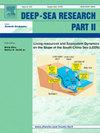MaxEnt modeling for predicting the present-day and future potential geographical distribution of coral/algae in the Persian Gulf under climate change
IF 3
3区 地球科学
Q2 OCEANOGRAPHY
Deep-sea Research Part Ii-topical Studies in Oceanography
Pub Date : 2025-08-13
DOI:10.1016/j.dsr2.2025.105529
引用次数: 0
Abstract
The Persian Gulf forms a natural geographic barrier to coral reef communities. This study employs MaxEnt modeling with environmental data from Bio-ORACLE to assess the potential distributions of coral/algae and microalgal mats under present conditions and future (2090–2100) scenarios for SSP1, SSP3, and SSP5. Maximum temperature and mixed layer depth were found as the key environmental variables defining habitat suitability. Present-day suitable habitat for coral/algae totals approximately 94,161 km2. Under SSP1, a moderate decline of 2.29 % (to ∼92,002 km2) in habitat area is projected. SSP3 scenario shows an increase of 14.32 % (up to ∼107,651 km2), potentially due to local adaptation. In comparison, SSP5 projects a severe 18.14 % decrease (∼77,072 km2) with fragmentation and isolation characterized by a 40 % drop in effective mesh size and 130 % increase in edge density. Microalgal mats exhibited an increasing area and connectivity under more severe scenarios, with the total core area rising from ∼5.2 million to over 16.7 million square units. The largest patch index exceeded 82 %, and the aggregation index peaked near 95 %. Biotic velocity metrics suggested that microalgal mats require movements exceeding 1400 m/year, which is higher than those of coral/algae. North-south direction dominates patterns of change in distribution. These results underscore the need for targeted conservation that prioritizes connectivity and scenario-sensitive management actions in response to climate change in the Persian Gulf.
在气候变化条件下预测波斯湾珊瑚/藻类现在和未来潜在地理分布的MaxEnt模型
波斯湾形成了珊瑚礁群落的天然地理屏障。本研究利用MaxEnt模型和Bio-ORACLE的环境数据,评估了SSP1、SSP3和SSP5在当前条件和未来(2090-2100年)情景下的潜在珊瑚/藻类和微藻垫分布。最高温度和混合层深度是决定生境适宜性的关键环境变量。目前适合珊瑚/藻类的栖息地总面积约为94,161平方公里。在SSP1下,预计栖息地面积将中度减少2.29%(至~ 92,002 km2)。SSP3情景显示增加14.32%(高达~ 107,651 km2),可能是由于局部适应。相比之下,SSP5预计严重减少18.14% (~ 77,072 km2),碎片化和隔离的特征是有效网格大小下降40%,边缘密度增加130%。在更严重的情景下,微藻垫的面积和连通性不断增加,总核心区面积从约520万平方单位增加到超过1670万平方单位。斑块指数最大超过82%,聚集指数最高接近95%。生物速度指标表明,微藻垫需要超过1400 m/年的移动量,高于珊瑚/藻类。分布变化格局以南北方向为主。这些结果强调了有针对性的保护的必要性,优先考虑连通性和场景敏感的管理行动,以应对波斯湾的气候变化。
本文章由计算机程序翻译,如有差异,请以英文原文为准。
求助全文
约1分钟内获得全文
求助全文
来源期刊
CiteScore
6.40
自引率
16.70%
发文量
115
审稿时长
3 months
期刊介绍:
Deep-Sea Research Part II: Topical Studies in Oceanography publishes topical issues from the many international and interdisciplinary projects which are undertaken in oceanography. Besides these special issues from projects, the journal publishes collections of papers presented at conferences. The special issues regularly have electronic annexes of non-text material (numerical data, images, images, video, etc.) which are published with the special issues in ScienceDirect. Deep-Sea Research Part II was split off as a separate journal devoted to topical issues in 1993. Its companion journal Deep-Sea Research Part I: Oceanographic Research Papers, publishes the regular research papers in this area.

 求助内容:
求助内容: 应助结果提醒方式:
应助结果提醒方式:


